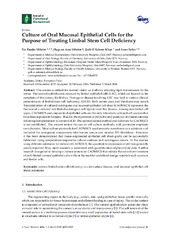| dc.contributor.author | Utheim, Tor Paaske | |
| dc.contributor.author | Utheim, Øygunn Aass | |
| dc.contributor.author | Khan, Qalbi | |
| dc.contributor.author | Sehic, Amer | |
| dc.date.accessioned | 2017-03-20T14:23:36Z | |
| dc.date.available | 2017-03-20T14:23:36Z | |
| dc.date.issued | 2016-03-01 | |
| dc.description.abstract | The cornea is critical for normal vision as it allows allowing light transmission to the
retina. The corneal epithelium is renewed by limbal epithelial cells (LEC), which are located in the
periphery of the cornea, the limbus. Damage or disease involving LEC may lead to various clinical
presentations of limbal stem cell deficiency (LSCD). Both severe pain and blindness may result.
Transplantation of cultured autologous oral mucosal epithelial cell sheet (CAOMECS) represents the
first use of a cultured non-limbal autologous cell type to treat this disease. Among non-limbal cell
types, CAOMECS and conjunctival epithelial cells are the only laboratory cultured cell sources that
have been explored in humans. Thus far, the expression of p63 is the only predictor of clinical outcome
following transplantation to correct LSCD. The optimal culture method and substrate for CAOMECS
is not established. The present review focuses on cell culture methods, with particular emphasis
on substrates. Most culture protocols for CAOMECS used amniotic membrane as a substrate and
included the xenogeneic components fetal bovine serum and murine 3T3 fibroblasts. However,
it has been demonstrated that tissue-engineered epithelial cell sheet grafts can be successfully
fabricated using temperature-responsive culture surfaces and autologous serum. In the studies
using different substrates for culture of CAOMECS, the quantitative expression of p63 was generally
poorly reported; thus, more research is warranted with quantification of phenotypic data. Further
research is required to develop a culture system for CAOMECS that mimics the natural environment
of oral/limbal/corneal epithelial cells without the need for undefined foreign materials such as serum
and feeder cells. | en_US |
| dc.description.sponsorship | Funding: Department of Oral Biology, Faculty of Dentistry, University of Oslo and Department of Medical Biochemistry, Oslo University Hospital, Oslo, Norway. | en_US |
| dc.description | Source: <a href=http://dx.doi.org/10.3390/jfb7010005>doi: 10.3390/jfb7010005</a> | en_US |
| dc.identifier.citation | Utheim TP, Utheim ØA, Khan KA, Sehic A. Culture of Oral Mucosal Epithelial Cells for the Purpose of Treating Limbal Stem Cell Deficiency. Journal of Functional Biomaterials. 2016 | en_US |
| dc.identifier.cristinID | FRIDAID 1346744 | |
| dc.identifier.doi | 10.3390/jfb7010005 | |
| dc.identifier.issn | 2079-4983 | |
| dc.identifier.uri | https://hdl.handle.net/10037/10790 | |
| dc.language.iso | eng | en_US |
| dc.publisher | MDPI | en_US |
| dc.relation.journal | Journal of Functional Biomaterials | |
| dc.rights.accessRights | openAccess | en_US |
| dc.subject | VDP::Medisinske Fag: 700::Basale medisinske, odontologiske og veterinærmedisinske fag: 710 | en_US |
| dc.subject | VDP::Medical disciplines: 700::Basic medical, dental and veterinary science disciplines: 710 | en_US |
| dc.subject | Medisinsk biologi / Medical biology | en_US |
| dc.title | Culture of Oral Mucosal Epithelial Cells for the Purpose of Treating Limbal Stem Cell Deficiency | en_US |
| dc.type | Journal article | en_US |
| dc.type | Tidsskriftartikkel | en_US |
| dc.type | Peer reviewed | en_US |


 English
English norsk
norsk
